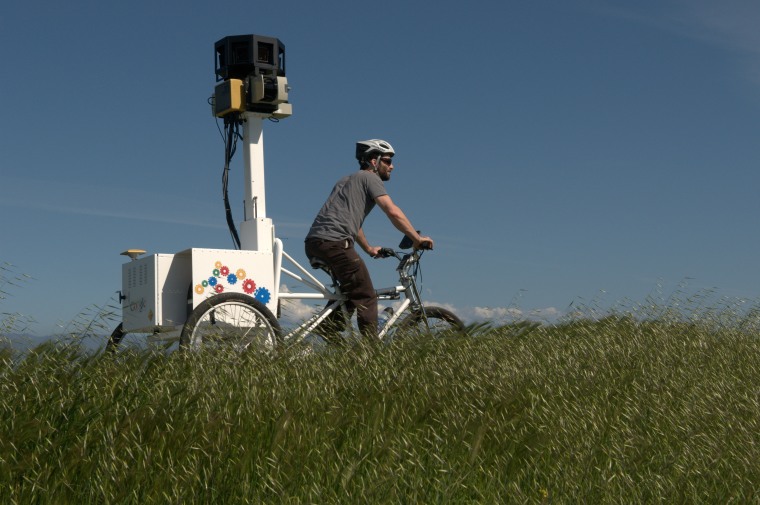Sure, it seemed creepy at first … maybe even creepy still. But there’s no denying that Google Street View, a function of Google Earth and Google Maps, is also wicked cool. Giving a whole new meaning to “I can see my house from here,” Google Street View provides 360-degree horizontal and 290-degree vertical views of streets all over the planet via a few clicks on your keyboard.
Until recently however, if your house — or any other location — happened to be located down an alley or street too narrow for a Google Street View car — those camera-equipped autos combing the globe for images — it remained out of the Internet's pictures. Thanks to the Google Street View Trike, introduced to the public via a pick-the-next-location contest, that could soon change.
“This mechanical masterpiece consists of three bicycle wheels, a mounted Street View camera and a specially decorated unit with imaging and GPS technology,” gushes Google’s press release announcing the contest. Users were invited to vote for nominees in six categories: parks and trails, university campuses, theme parks and zoos, pedestrian malls (e.g., outdoor shopping areas, boardwalks), landmarks and sports venues (e.g., golf courses, racing tracks, stadium grounds). The winners in each category, to be announced later this month, will be mapped by the Google Trike.
When the Google Street View Trike rolled around 30 Rockefeller Center, The TODAY Show and Technotica checked it out and had to agree: When it comes to 250-pound tricycles packing 360-degree camera equipment and computer hardware, it’s pretty awesome.
Of course, there are privacy issues. There’s also a whole bunch of technology packed on to something usually seen hauling tourists or ice cream, beaming super-detailed images indirectly to the Internet, which allow you to see the most minute detail from your desktop.
Slideshow 8 photos
8 amazing bionic animals
“The Trike is an extension of the Google Street View car,” says Daniel Ratner, senior mechanical engineer on Google’s Street View team. He's also an avid cyclist and the guy who thought the whole thing up. “We wanted to keep all the same functionality that you can find on the Google Street View car, but put it on a smaller package.”
His first thoughts for the Street View Trike came while on vacation in Barcelona, Spain, while he and his wife walked 30 minutes through winding cobblestone alleyways — too narrow for a taxi cab — to reach the hotel they had booked online.
“In these alleyways, you would find the cafes and guitar shops and clothing stores, and frankly some of the most interesting hip fun places in the city.”
How awesome would it be, Ratner said (and I paraphrase), if you could check out the proximity of all these locations before you left your hotel — or even left for your trip? “When we got back from the trip in Spain to California (Google and Ratner’s home base), I worked with my teammates to try and lift things off the ground and get the Trike going.”
Things didn’t lift smoothly, however, and the first prototype failed. That’s when serendipity — and more of Ratner’s off time — came back into play. Ratner spied a pedicab while out for coffee with his wife and sweet-talked the driver into test driving it. Riding the pedicab around, Ratner realized that “something that nice and that strong would serve as a fantastic base structure we could engineer up for the Google Trike.”
The Google Trike made its public appearance at Legoland earlier this year, as it mapped the California amusement park. The reception it received was pretty much the same it got rolling around the 30 Rock Plaza, says Ratner. It seems that anywhere the a Google Trike turns up, eye-popping excitement ensues — even though the high-tech machine is sometimes mistaken for an ice cream vendor mobile.
“Cool! Mommy, look at the robot” and “Wow! Is that Street View? Do you really ride that trike across the whole country?” are common reactions from children and adults (respectively), notes Ratner, who says he was lucky enough to pilot the Trike at its Legoland debut.
“Well who doesn’t like a bike?” Ratner says (rhetorically). “It’s accessible. We all grew up riding these things. It’s a bike, but it’s pimped out with lots of high-tech hardware.”
Indeed, on its tour around 30 Rock Plaza, it passed nary a resident or tourist who could resist whipping out a video camera or cell phone for a quick shot as it passed by. One family from Japan didn’t speak much English, but that didn’t stop them requesting, and receiving, a group shot with the Google Trike.
Not that Google Street View — car or Trike — gets a raving reception in every country where it rolls. Here in the United States, there were early issues with Google Maps revealing sensitive areas such as domestic abuse shelters and military bases. Even with the implementation of facial recognition software, which blurs the images of people captured on Street View, the privacy issue is not resolved.
Earlier this year, residents of Broughton in Buckinghamshire, England, formed a human shield to prevent the Google Street View car from entering the village. One might posit that it was a bit of a goodwill gesture when Google launched its contest allowing people to vote for places they’d like the Trike to map, well before a similar contest was launched for the United States locations. And Google has assured in press releases that it will “work closely with the relevant organizations to collect images of privately-owned locations.”
Indeed, there is an upside to having the Google name behind your Trike. Tourists have not been permitted past the fence at Stonehenge in years, but the Google Trike mapped it up close and personal.
Meanwhile, here in the United States, Ratner himself has already mapped Arastradero Open Preserve in northern California, San Diego State University, Monterey coastal bike path and the Santa Monica Pier. As bikers take on mountain roads, the Google Trikes have been put to the durability test. A few took a tumble down some steep inclines, but so far, neither rider, trike nor road have been harmed in the filming.
Friend Helen A.S. Popkin on or follow her on where she posts slightly out-of-focus iPhone pics she snaps from of a fixed-gear bike named "Bruce" that somebody left on the street.

